| |
|
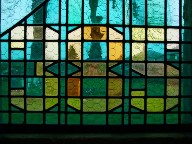 |
|
The villages in this part of
Suffolk are working villages, too far
from anywhere important, and too
agri-industrialised for them to be
attractive to commuters. But the setting
of All Saints is delightful, set on a
slight rise with a stream along the edge
of the churchyard. You have to cross a
watersplash to reach it. The churchyard
has an abundance of 19th Century
headstones, a reminder that the rural
population of East Anglia reached its
peak with the 1851 census, and has been
falling away ever since. Steps
on the south-eastern corner of the
churchyard lead you to a memorial to the
385th Bombardment Group of the US 8th Air
Force. The tower is rather severe,
relieved slightly by a curious little
spike as if we were in Hertfordshire and
not in East Anglia at all. The stairway
acts as a buttress to to south east
corner.
|
The
16th Century red brick porch is the real delight
dressed in flint and entirely in the style of
Suffolk's more common flint ones of a decade
earlier. It is reminiscent of the red brick porch
at Ixworth Thorpe, a few miles to the west, and
Sam Mortlock found the same little heads used as
decoration on both, suggesting that they were the
work of the same builder.
The
church is open every day. You step into a rather
crowded nave, full of interest.
One very unusual survival is a
medieval bench which has mermaids at both ends.
Both are badly damaged, one losing her front and
the other all but part of the tail, but they are
still recognisable as such, and were clearly once
grander than their sister across the fields at
Stowlangtoft. Interestingly, they faced different
directions.
  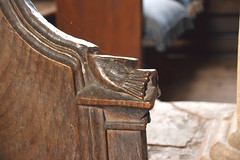
Turning
to the east, you see a chancel full of coloured
light from the AK Nicholson east window. it
depicts the Risen Christ with attendant angels,
and at the bottom are a sower in a field, and an
angel reaping sheaves of wheat, both figures
carrying out duties which must have seemed
entirely familiar to locals as late as 1926, when
this window was installed. AK Nicholson was the
artist of the apotheosis of Anglicanism in the
1920s. Here you see the triumph of the Church of
England before its long, slow decline over the
next five decades.
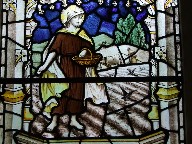 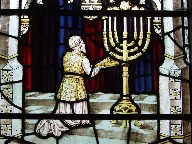 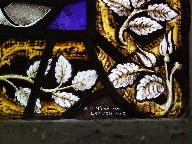 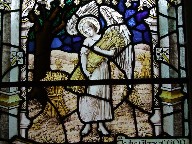
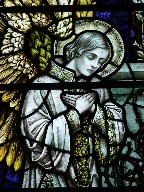 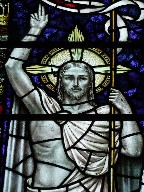 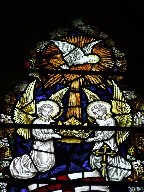 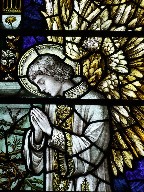
At the east end of the north aisle
is the feature which will be of most interest to
many visitors, the memorial chapel to 385
Bombardment Group. The design was one of the last
works of the great H Munro Cautley as diocesan
architect, full at once of his intelligent
mediaevalism and the cinema deco which often
informs his work. The later window to the north
is by the Suffolk-based artist Surinder Warboys,
the upper part depicting the bombers flying out
across a Suffolk sky.
But perhaps the most
singular feature of All Saints, and one
not easily missed, is the imposing
pulpit, one of the biggest and squarest
of its kind in Suffolk. It is dated 1619
at the front of the tester, and Sam
Mortlock thinks it was probably donated
by William Fyrmage, a known benefactor at
the time and the probable reason for the
intials WF at the back. Near it, a stall
is carved with blacksmith's tools.
Nicholas Fyrmage, another benefactor, has
a most curious early 17th Century charity
board in his honour, stretching out like
an unfurled scroll and now attached to
the chancel wall. The reason for its
nature is that it was originally
displayed along the roodbeam, a constant
reminder to locals of his generosity. |
|
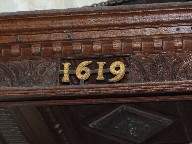 |
|
|
|

